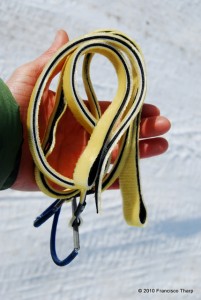
Kick skins: the most useful handful of gear since GORP. These BCA Skin scraps I use weigh in at 65g, including the tip clip. Add a hyper light stuff sack and total weight is 77g.
Unless you’re skiing the Red Lady, just about every backcountry ski tour in Crested Butte requires a fairly flat valley approach of 1 to 3 miles. The tried and true method for these laborious tours is to slog in and slog out with big fatty skins on those big fatty skis that are so much fun in powder. I’ve tried other methods, too. One day I skied home from Snodgrass with one skin on, one skin off, like some kind of seizing, lurching skateboarder. Granted, I made it back to the car before my ski partners, but when I got there I was so off balance I could only walk in counter-clockwise circles for a good four minutes. I’ve also tried kick wax, but that stuff’s too gunky; if you use it before the climb it’ll mank up your skins and then kill your downhill buzz.
Enter kick skins. In a nut shell, kick skins kick ass. I learned about them from all the ski gurus in Crested Butte: those folks who routinely ski over to Aspen for a latte in the morning and make it back in time for the Teocalli Bowl rope drop; those folks who glide past Chuck Norris on the Nordic trails and drop pointers on his technique.
Kick skins are like the thong of climbing skins: sleek, slender and sassy. They are essentially super thin skins that cover just enough of your base to give a little kick, and still allow for a substantial glide.
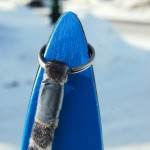
Key ring tip clip for the Nordic skis. Note the duct tape reinforcement: uber importante.
I like to use the scraps from when I trim my fat skins. That way I don’t spend as much money and I throw less away. “A skin saved is a skin earned,” George Washington once told his father as he chopped down a pesky apple tree.
Then, I scavenge some kind of tip loop set up. For my Nordic skis (Tempo classic skis that are older than I am) a key ring works well. Those are cheap at any thrift shop of hardware store. For my telemark skis (Black Diamond Nunyos and BD Kilowatts) I use standard skin loops. I regularly find these cheap at used gear shops, or from friends getting rid of old, goobery skins. I just run about 1.5 inches of the skin tip through the tip loop, fold the skin back on itself, and secure with a couple wraps of duct tape. I don’t bother with tail clips or fixtures: remember, we’re aiming for glide here.
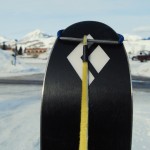
Fat tip clips for my tele skis. Again, gotta use the duct tape 'cause the skin's so skinny.
I use 18mm skins on my Nunyos (105-73-93mm wide) and my BD Kilowatts (125/95/112 mm wide) – not because this is some sort of magic ratio, but because that’s how wide my skin scraps ended up being. I use 25mm skins on my 50mm Nordic skis because I only carry one set of skins Nordic skiing, and I might need them to actually climb some hills, while on my tele skis, I’ll have fat skins for any serious climbing. Another trick: I carry two kick skins and one full width skin for my Nordic skis. If I really need to climb, I can put both kick skins on one ski, and the fatty on the other.
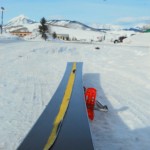
Right down the middle = more kick, better climbing, less thinking.
Now, there’s a couple ways I’ve used kick skins. There’s the good old fashioned missionary positioning, where you just run the skin down the middle of the ski. Or, for those who like to live on the edge, you can run the skin along the outer edges.
Missionary’s good for greater kick, steeper climbing and more mindless plodding. The edge method requires slightly more technique, but can pay off with speed and longevity: it allows some skating, and if you weight your outside edge on the kicks and your inside edge on the glides, you’ll be cruising. This can feel awkward at first, but which great things in life don’t?
Despite all their newfound fame and glory, kick skins also have some drawbacks, limitations, and special considerations. First, they add weight to your pack. If you’re going to be doing any substantial climbing, you’ll have to carry both kick skins and fat skins.
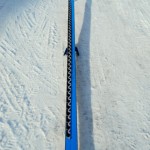
Outside edge placement = skating options, and greater kick and glide potential with proper technique.
I found my kickers to lose traction once the slope got to be above 15 degrees, or so, but this will depend on your skin-to-ski width ratios. Second, you’ll probably want a little stuff sack to keep them dry and clean. Kickers are skinny and lack tail clips, so any loss of stickiness is a bummer. A little dog hair on a full skin might not matter much, but on a kick skin it could neutralize a high percentage of your adhesive.
If any of you readers have used kick skins and would like to share any beta or experiences, feel free to use the comment form below. I’d love to hear about it!
Kick on dudes and dudettes.

